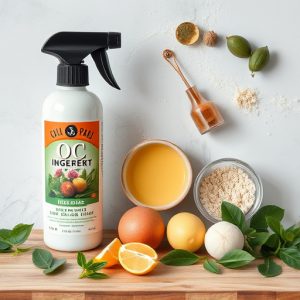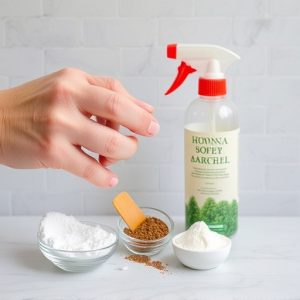Decoding Oleoresin Capsicum (OC Spray): Science, Safety, and Self-Defense Applications
Oleoresin capsicum (OC) is a key component in non-lethal self-defense sprays, derived from Capsicum…….
Oleoresin capsicum (OC) is a key component in non-lethal self-defense sprays, derived from Capsicum Annuum peppers. Its effectiveness lies in its high capsaicin content, which measures in Scoville Heat Units (SHU), causing intense irritation to the eyes, skin, and respiratory system upon contact, leading to rapid incapacitation of an attacker. The formulation process for OC spray involves careful concentration of capsaicinoids in a solvent base to ensure efficacy and safety, adhering to strict regulations that govern its use and manufacture. OC spray is not only a personal defense tool but also used by law enforcement for managing crowds and apprehending suspects. The composition of OC sprays, including their concentration levels, is subject to local laws and must be understood by users to ensure legal and safe application, particularly considering the sensitive nature of its effects on individuals with pre-existing health conditions. Proper knowledge of OC spray ingredients and their potential impact is essential for anyone considering this self-defense option.
Understanding Oleoresin Capsicum: A Comprehensive Overview
Oleoresin capsicum, commonly known as oleoresin of Capsicum Annuum, is a concentrated extract derived from chili peppers. It encapsulates both the essential oils and resinoids of the pepper, which contribute to its characteristic pungency and color. This compound is widely recognized for its role in pepper sprays used for self-defense due to its potent irritant properties when in contact with mucous membranes. Understanding its composition is crucial for effectively utilizing oleoresin capsicum in various applications, including personal defense products and gourmet food flavoring.
The primary ingredients of OC (oleoresin capsicum) spray are capsaicinoids, with capsaicin being the most abundant. These active components are responsible for the heat level of the pepper and are measured in Scoville Heat Units (SHU). The formulation of an OC spray typically includes a base solvent, often alcohol or oil, which helps in evenly distributing the capsaicinoids. The specific ingredients can vary depending on the manufacturer’s design and the intended use of the product. For instance, in personal defense sprays, the ingredients are carefully selected to maximize the efficiency and safety of the product, ensuring it is both potent and non-lethal. Additionally, the formulation must adhere to strict regulations to guarantee user protection and environmental safety.
The Science Behind OC Spray Ingredients: Capsaicin and Its Derivatives
Oleoresin capsicum (OC) spray is a non-lethal self-defense tool that utilizes the active ingredient capsaicin, derived from chili peppers. Capsaicin and its derivatives are the primary components responsible for the potent effects of OC spray. These substances induce an intense burning sensation upon contact with mucous membranes or skin, leading to immediate incapacitation of an attacker by causing severe eye pain, coughing, and difficulty in breathing. The mechanism behind capsaicin’s effects is rooted in its interaction with a subset of sensory neurons that detect heat and pain. When OC spray is deployed, the capsaicinoid compounds bind to these receptors, triggering an overstimulation response that overwhelms the neural pathways responsible for perceiving pain. This overstimulation manifests as the sensation of burning, which can be so debilitating that it immobilizes the attacker, providing the opportunity for escape or intervention by authorities.
The efficacy of OC spray relies on precise formulations of capsaicin and its derivatives to ensure optimal performance under various conditions. The ingredients in OC spray are designed to penetrate effectively through clothing and overcome environmental factors such as wind, weather, and distance. The concentration of capsaicinoids is critical; too little may be ineffective, while too much could lead to unnecessary harm or legal complications. Manufacturers often include additional ingredients like oils from the capsicum plant to enhance the spray’s range and retention on skin and mucous membranes. Understanding the science behind these ingredients is essential for selecting an OC spray that offers robust defense while adhering to safety standards and legal regulations.
Applications and Uses of Oleoresin Capsicum in Self-Defense and Personal Safety
Oleoresin capsicum (OC), commonly known as pepper spray, is a formidable deterrent in personal safety and self-defense arsenals. It consists of oils and resins extracted from chili peppers that deliver a potent irritant to any potential assailant. The primary ingredients in OC spray include capsaicin and related capsaicinoids, which cause intense burning and irritation upon contact with mucous membranes and skin. This non-lethal defense mechanism is specifically engineered to incapacitate an attacker by triggering uncontrollable coughing, wheezing, and an inability to see, thus providing a critical window of escape for the victim. The effectiveness of OC spray lies not only in its immediate impact but also in its deterrence; would-be aggressors are often dissuaded by the mere presence of such a defense due to its well-known effects.
The applications and uses of OC sprays extend beyond personal self-defense. Law enforcement agencies worldwide utilize OC for crowd control, non-lethal apprehension of suspects, and de-escalation of potentially violent situations. The ingredient profile of OC spray is carefully regulated to comply with legal standards that ensure it is effective without causing undue harm. This makes OC sprays a preferred choice over traditional firearms for security personnel in various settings, including schools, airports, and businesses. The availability of different formulations, such as foam, gel, or pepper spray, further enhances the versatility of OC sprays in self-defense scenarios, making them an indispensable tool for anyone prioritizing their safety and well-being.
Safety, Regulations, and Considerations When Using OC Spray Products
Oleoresin capsicum, commonly known as OC, is a powerful defense mechanism found in pepper sprays. When considering the use of OC spray products for self-defense, safety and regulation are paramount. The ingredients in these sprays, primarily oleoresin capsicum combined with other resinoids from chili peppers, can cause significant irritation to the eyes, skin, and respiratory system of an attacker. It’s crucial to handle OC spray products with care, as accidental exposure can lead to discomfort and injury. Regulations governing the use of these sprays vary by jurisdiction; users must familiarize themselves with local laws. These regulations often dictate the concentration of oleoresin capsicum in the spray, the conditions under which it can be legally used, and any restrictions on who may purchase or possess the product. Users should also consider the potential effects on individuals with pre-existing health conditions and ensure that the use of OC spray does not pose an unreasonable risk to them or bystanders. Adherence to safety guidelines, understanding of local regulations, and careful consideration of personal health and environmental factors are essential when integrating OC spray into one’s self-defense plan.


